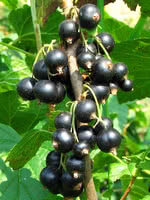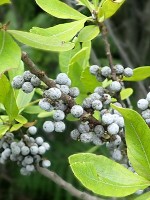Mon-Fri 9am - 5pm Mountain time
Blackcurrant vs Northern Bayberry
Ribes nigrum
Myrica pensylvanica
NOT AVAILABLE THIS SEASON - MIGHT RETURN
NOT AVAILABLE THIS SEASON - MIGHT RETURN
Blackcurrant is a medium-sized shrub producing delicious, deep purple to black sweet berries suitable for jams, jellies, syrups and cordial.
Our Blackcurrant is grown from seed from the "Ben" series of Blackcurrant cultivars, developed by the Mylnefield Research Station in Scotland with a focus on cold hardiness and heavy commercial fruit production. Our seedlings will be slightly different due to hereditary differences but will be very similar to this series.
Northern Bayberry makes an excellent hedge or feature shrub. It will retain its leaves in warmer climates but drops them in colder areas. They produce blue-grey berries that have a wax coating on them that can be used to make candles or soaps.
In colder hardiness zones the leaves turn an attractive orange to red colour in the fall, making it a striking addition to your landscape.
Northern Bayberry is native to Nova Scotia and tolerates both drought and wet conditions. It is also a nitrogen fixer that tolerates poor soil conditions.
Blackcurrant Quick Facts
Northern Bayberry Quick Facts
Toxicity: Warning: The wax from bayberry fruit is considered toxic and may be carcinogenic.

